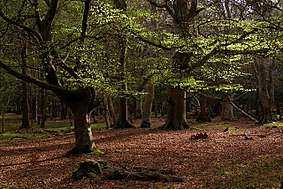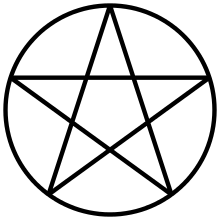Coven
A coven /kʌvən/ usually refers to a gathering of witches. The word "coven" remained largely unused in English until 1921 when Margaret Murray promoted the idea, now much disputed, that all witches across Europe met in groups of thirteen which they called "covens".[1]
Neopaganism

In Wicca and other similar forms of modern neopagan witchcraft, such as Stregheria and Feri, a coven is a gathering or community of witches, much like a congregation in Christian parlance. It is composed of a group of believers who gather together for ceremonies of worship such as Drawing Down the Moon, or celebrating the Sabbats.
The number of persons involved may vary. Although some consider thirteen to be ideal (probably in deference to Murray's theories), any group of at least three can be a coven. A group of two is usually called a "working couple" (regardless of the sexes). Within the community, many believe that a coven larger than thirteen is unwieldy, citing unwieldy group dynamics and an unfair burden on the leadership.[2] When a coven has grown too large to be manageable, it may split, or "hive". In Wicca, this may also occur when a newly made High Priest or High Priestess, also called 3rd Degree ordination, leaves to start their own coven.
Wiccan covens are usually jointly led by a High Priestess and a High Priest, although some are led by only one or the other. In more recent forms of neopagan witchcraft, covens are sometimes run as democracies with a rotating leadership.
Online covens
With the rise of the Internet as a platform for collaborative discussion and media dissemination, it became popular for adherents and practitioners of Wicca to establish "online covens" which remotely teach tradition-specific crafts to students in a similar method of education as non-religious virtual online schools. One of the first online covens to take this route is the Coven of the Far Flung Net (CFFN), which was established in 1998 as the online arm of the Church of Universal Eclectic Wicca.
However, because of potentially-unwieldy membership sizes, many online covens limit their memberships to anywhere between 10 and 100 students. The CFFN, in particular, tried to devolve its structure into a system of sub-coven clans (which governed their own application processes), a system which ended in 2003 due to fears by the CFFN leadership that the clans were becoming communities in their own right.
Other contemporary forms
The Urban Coven is a group founded on Facebook by Becca Gordon for women in Los Angeles to gather, hike, and howl at the moon. It meets monthly and is estimated to have almost 3,500 members. A January 2016 gathering at Griffith Park drew nearly 1,000 women, and was described as follows:
"Many of the women ... were there in groups — mothers and daughters, friends, colleagues. Some arrived solo and struck up conversations with other women or hiked in solitude."[3]
Usage in literature and popular culture
In fantasy stories and popular culture, a coven is a gathering of witches to work spells in tandem. Such imagery can be traced back to Renaissance prints depicting witches and to the three "weird sisters" in Shakespeare's Macbeth (1606).
Orgiastic meetings of witches are depicted in the Robert Burns poem "Tam o' Shanter" (1791) and in the Goethe play Faust (1832).
Films featuring covens include Rosemary's Baby (1968), Suspiria (1977), The Witches of Eastwick (1987), Four Rooms (1995), The Craft (1996), Coven (1997), Underworld (2003), Underworld: Evolution (2006), The Covenant (2006), Paranormal Activity 3 (2011), and The Witch (2015).
In television, covens have been portrayed in the U.S. in supernatural dramas such as Charmed, Witches of East End, The Vampire Diaries, The Originals, The Secret Circle, True Blood, and Once Upon a Time. The third season of American Horror Story is entitled Coven and focuses on witches.
In vampire novels such as The Vampire Chronicles by Anne Rice and the Twilight series by Stephenie Meyer, covens are families or unrelated groups of vampires who live together.
Covens feature in the video game Dishonored, specifically in the DLC's Knife of Dunwall, and The Brigmore Witches.
See also
References
- ↑ Murray, Margaret (1921). The Witch Cult in Western Europe: A Study in Anthropology.
- ↑ K, Amber (2002). Coven Craft: Witchcraft for Three or More. Llewellyn Publications.
- ↑ Blumberg, Antonia (25 January 2016). "This Is What An 'Urban Coven' Looks Like". Retrieved 23 March 2018 – via Huff Post.
Bibliography
- Margot Adler (2006) Drawing Down the Moon (book). Penguin Books.
- Miriam Simos (1999) The Spiral Dance. San Francisco: Harper.
- Janet and Stuart Farrar (1996) A Witches' Bible: The Complete Witches Handbook. Phoenix Publishing.
External links
- List of Covens by Location at Witchvox
- Online Covens supported by SpellsOfMagic
- Choosing a Coven by Judy Harrow
- Choosing a Coven (advice on) by Lisa McSherry
- Information on Covens by Spell Reviews
